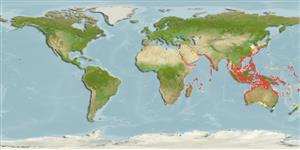>
Scombriformes (Mackerels) >
Scombridae (Mackerels, tunas, bonitos) > Scombrinae
Etymology: Scomberomorus: Latin, scomber = mackerel + Greek, moros = silly, stupid (Ref. 45335).
More on author: Lacepède.
Environment: milieu / climate zone / depth range / distribution range
Ecologia
marinhas; oceanódromo (Ref. 51243); intervalo de profundidade 10 - 70 m (Ref. 12260). Tropical; 39°N - 41°S, 7°W - 170°W (Ref. 54880)
Indo-West Pacific: Red Sea and South Africa to Southeast Asia, north to China and Japan and south to southeast Australia, and to Fiji (Ref. 6390). Immigrant to the eastern Mediterranean Sea by way of the Suez Canal. Southeast Atlantic: St. Helena.
Comprimento de primeira maturação / Tamanho / Peso / Idade
Maturity: Lm 75.2, range 55 - 82 cm
Max length : 240 cm FL macho/indeterminado; (Ref. 5765); common length : 120 cm TL macho/indeterminado; (Ref. 5450); peso máx. publicado: 70.0 kg (Ref. 5765); idade máx. registrada: 22 anos (Ref. 50580)
Espinhos dorsais (total) : 15 - 18; Raios dorsais (total) : 15 - 20; Espinhos anais: 0; Raios anais : 16 - 21; Vértebras: 42 - 46. This species is distinguished by the following characters: body elongate (depth 4.8-5.6 in SL), moderately strongly compressed; upper jaw reaching to posterior margin of eye or slightly beyond; teeth in jaws strong and compressed; gill rakers of first gill arch 0-2 on upper limb and 1-8 on lower limb, total 1-8; 2 dorsal fins, D1 XV-XVIII and D2 15-20, followed by 8-11 finlets; anal fin originating below midpoint of second dorsal fin, with 16-21 soft rays, followed by 7-12 finlets; lateral line abruptly bent downward below end of second dorsal fin. Colour of back iridescent blue-grey, sides silver with bluish reflections, marked with numerous thin, wavy vertical bands; number of bars increases from as few as 20 in a 40 cm specimen to as many as 65 at 150 cm; juveniles frequently spotted (Ref. 9684, 90102).
A pelagic fish, inhabiting near edge of continental shelf to shallow coastal waters, often of low salinity and high turbidity (Ref. 30199, 48637); also found in drop-offs, and shallow or gently sloping reef and lagoon waters (Ref. 1602, 48637). Feed primarily on small fishes like anchovies, clupeids, carangids, also squids and penaeoid shrimps. Usually hunts solitary and often swim in shallow water along coastal slopes (Ref. 48637). Eggs and larvae are pelagic (Ref. 6769). Caught mainly with drift gill nets, bamboo stake traps, midwater trawls, and by trolling. Marketed mainly fresh; also dried-salted; commonly made into fish balls (Ref. 9684), frozen, smoked, and canned (Ref. 9987). A lipid-soluble toxin, similar to ciguatoxin has been found in the flesh of specimens caught on the east coast of Queensland, Australia. Known to undertake lengthy long-shore migrations, but permanent resident populations also seem to exist.
Depending on temperature regime, the spawning season may be more or less extended.
In Australian waters, each female spawns several times over the season, about 2 to 6 days apart (Ref. 30196), depending on the locality. Spanish mackerel spawn off the reef slopes and edges, and they form spawning aggregations in specific areas (Ref. 6390).
Collette, B.B. and C.E. Nauen, 1983. FAO Species Catalogue. Vol. 2. Scombrids of the world. An annotated and illustrated catalogue of tunas, mackerels, bonitos and related species known to date. Rome: FAO. FAO Fish. Synop. 125(2):137 p. (Ref. 168)
Status na Lista Vermelha da UICN (Ref. 130435)
Ameaça para os humanos
Reports of ciguatera poisoning (Ref. 168)
Uso pelos humanos
Pescarias: altamente comercial; peixe esportivo: sim
Ferramentas
Relatórios especiais
Baixar XML
Fontes da internet
Estimates based on models
Preferred temperature (Ref.
123201): 22.8 - 29, mean 28 °C (based on 1324 cells).
Índice de diversidade filogenética (Ref.
82804): PD
50 = 0.5000 [Uniqueness, from 0.5 = low to 2.0 = high].
Bayesian length-weight: a=0.00661 (0.00584 - 0.00747), b=3.00 (2.97 - 3.03), in cm total length, based on LWR estimates for this species (Ref.
93245).
Nível Trófico (Ref.
69278): 4.5 ±0.4 se; based on diet studies.
Generation time: 3.6 (2.2 - 5.2) years. Estimated as median ln(3)/K based on 32
growth studies.
Resiliência (Ref.
120179): médio(a), tempo mínimo de duplicação da população 1,4 - 4,4 anos (K=0.12-0.21; tm=2-3; tmax=14; Fec=590,000).
Prior r = 0.98, 95% CL = 0.65 - 1.47, Based on 1 full stock assessment.
Fishing Vulnerability (Ref.
59153): Moderate to high vulnerability (52 of 100).
Climate Vulnerability (Ref.
125649): High to very high vulnerability (75 of 100).
Nutrients (Ref.
124155): Calcium = 19.6 [8.5, 74.3] mg/100g; Iron = 0.719 [0.310, 1.705] mg/100g; Protein = 20.9 [19.6, 22.1] %; Omega3 = 0.222 [0.131, 0.380] g/100g; Selenium = 72.5 [25.5, 222.5] μg/100g; VitaminA = 13.6 [3.2, 60.0] μg/100g; Zinc = 0.508 [0.338, 0.818] mg/100g (wet weight); based on
nutrient studies.
